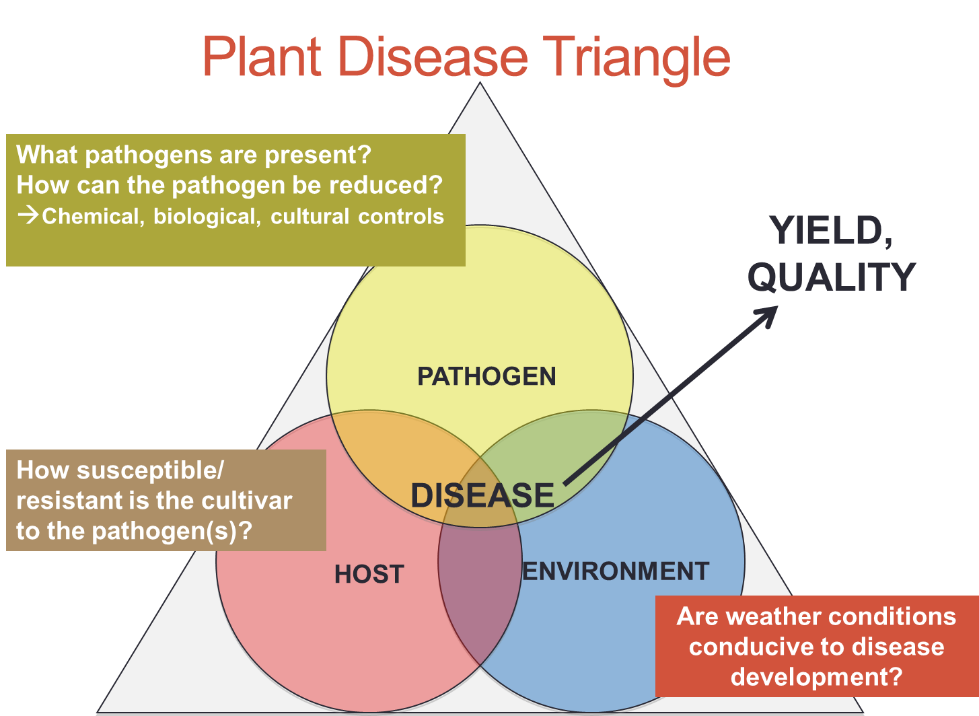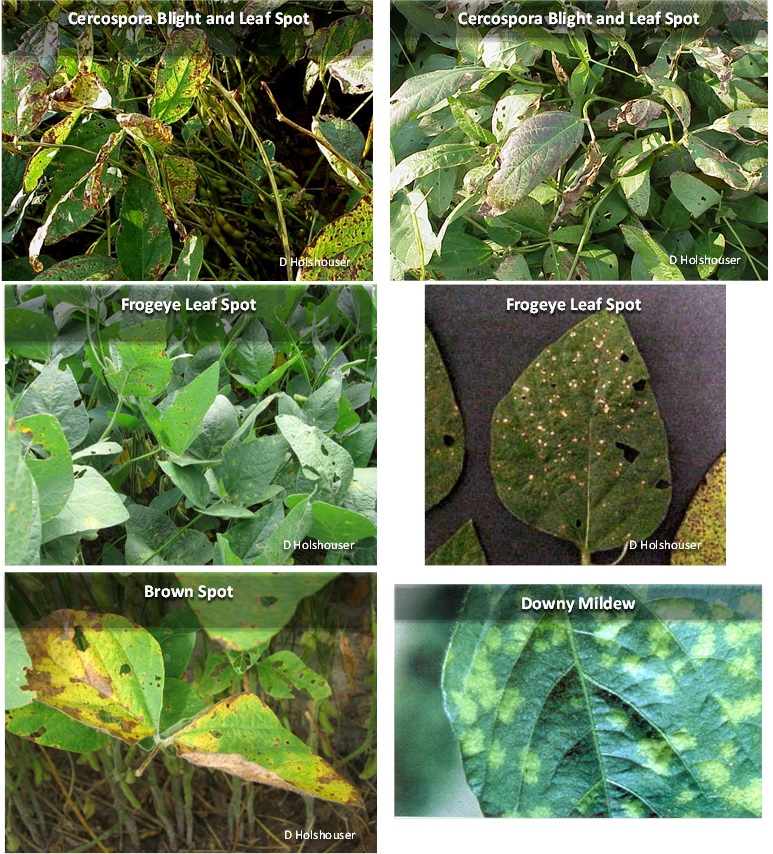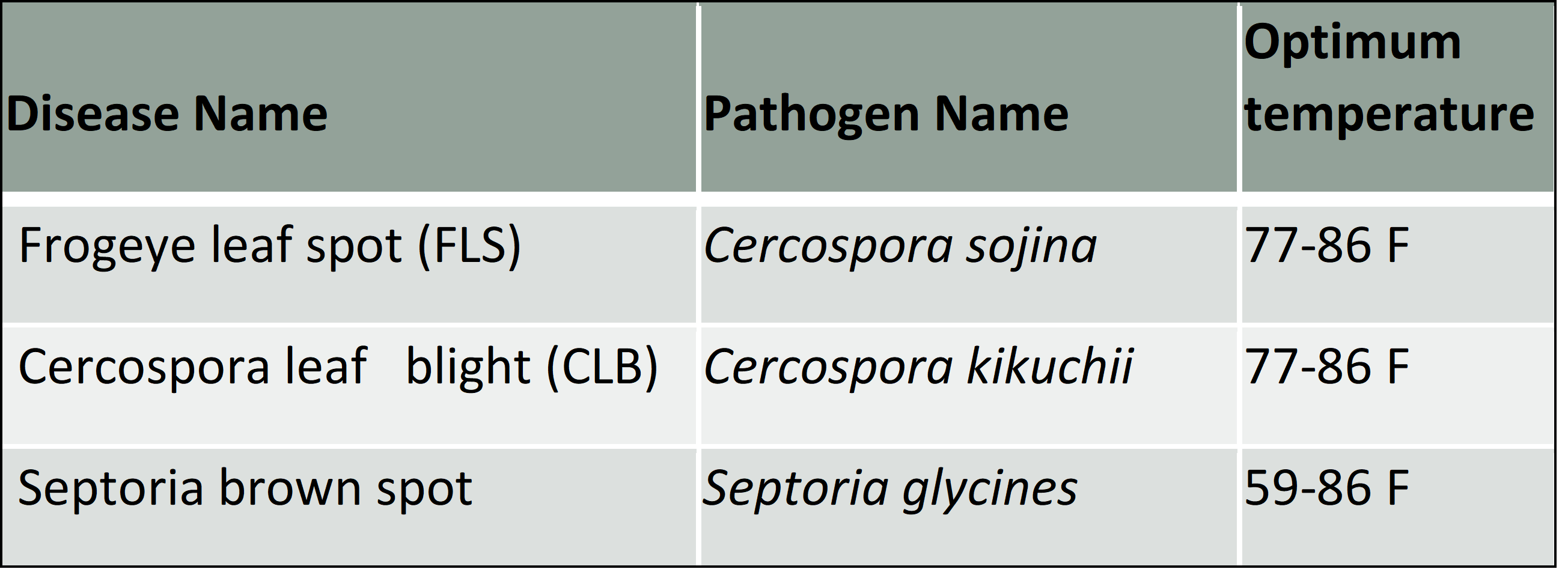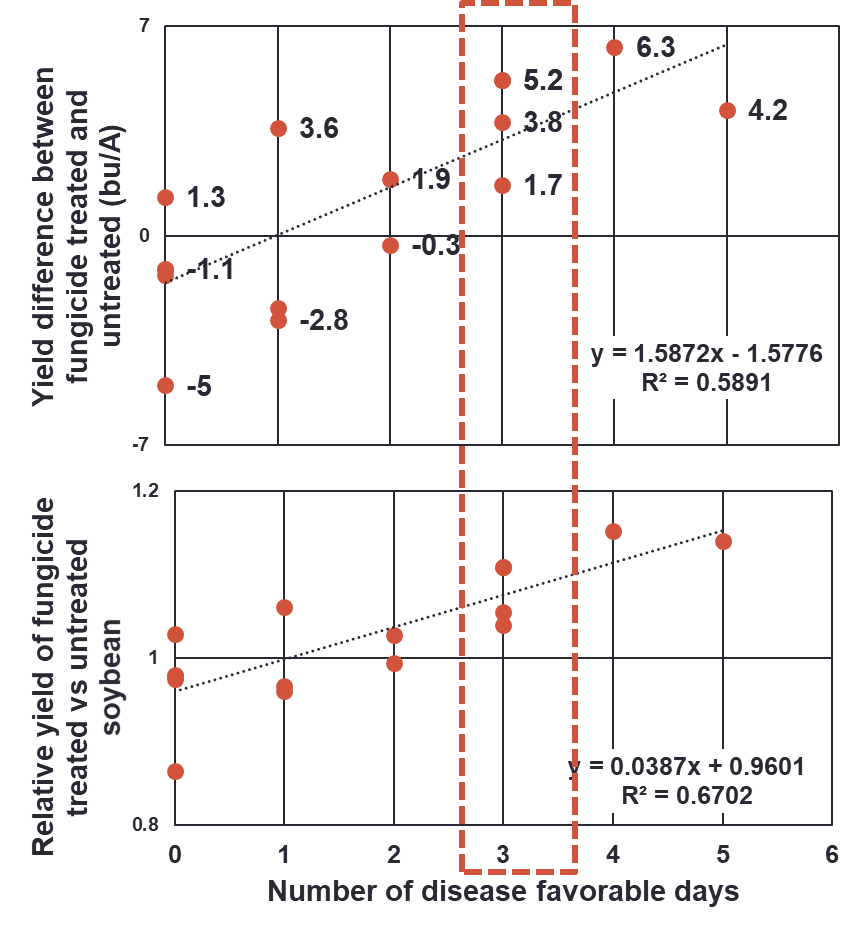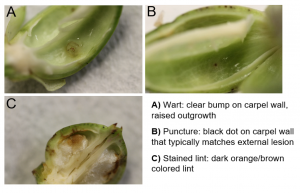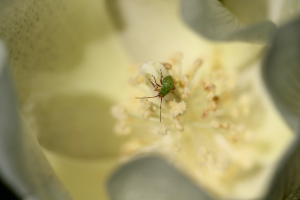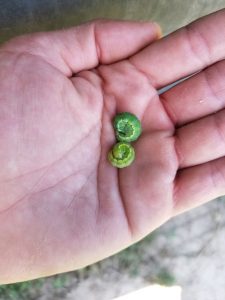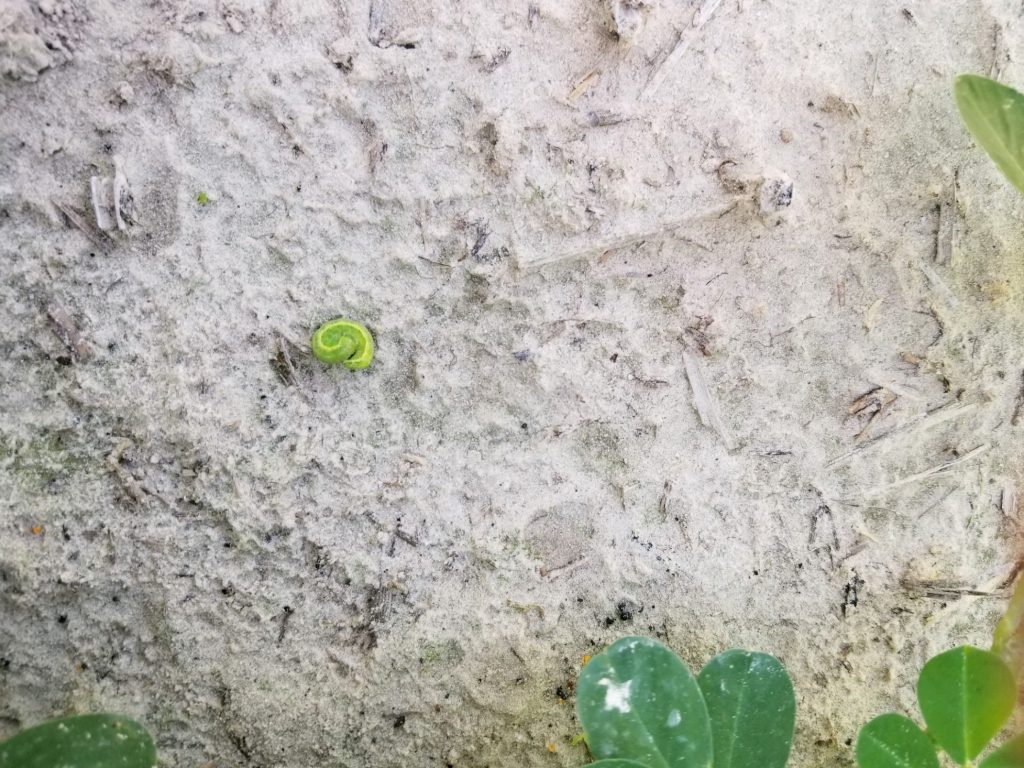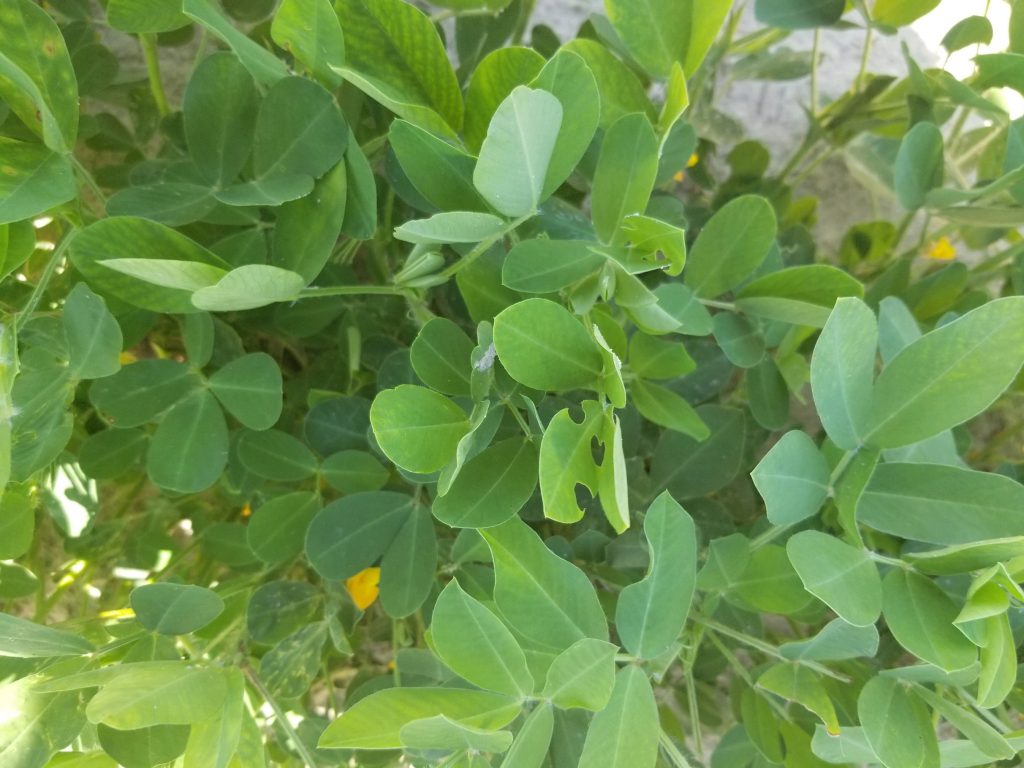Corn earworm moth catches in area black light traps averaged 2 to 45 per night. Please see the attached table for more details. blt_16_Aug_2018
Category Archives: Pest Group
Is it too late to apply foliar fungicides in soybean?
Hillary L. Mehl, Extension Plant Pathologist & David Holshouser, Extension Agronomist
The wet weather conditions, along with relatively cool temperatures over the last few weeks have been nearly perfect for disease development in soybean. As always, keep in mind the disease triangle – all 3 conditions must be met before a disease can form.
In most cases, one or more soybean pathogens are out there. Refer to previous blogs for more information on common soybean diseases: Now is a Good Time to Evaluate Your Varieties for Foliar Diseases and Foliar Fungicides for Soybeans. You can also access the Mid-Atlantic Soybean Disease Scouting Guide here. For a positive identification of the disease, send leaf samples to our diagnostic lab.
We also need a susceptible soybean variety (host). Some varieties are resistant to specific pathogens; others have some tolerance; many have neither.
Of the 3 conditions, the environment is the most difficult to assess. In general, we need high relative humidity (RH) for an extended period of time, usually over several days, and cool to moderate (e.g. not hot) temperatures.
Our research indicates that about 1/3 of the time, a foliar fungicide will result in yield increase. The probability and amount of response will of course depend on the disease. Frogeye leaf spot can be a quite devastating disease in susceptible soybean that have not been rotated. Cercospora leaf blight (sometimes called late blight) is less devastating, but is common in almost all of our soybean when conditions are right.
We have attempted to create a foliar fungicide decision aid that would help decide on whether or not to spray. The decision aid is based on the total number of favorable days for disease development, based on the data shown below.
We think that during the period of 1 week before and 1 week after mid-R3, yield-robbing disease levels may develop if we have 3 favorable days with 10 or more hours of relative humidity at or above 95% and temperatures in the optimum range (77 to 86 F). When these conditions are met, we would suggest a fungicide application.
However, after 3 years of on-farm testing we only improved the predictability of a yield increase slightly (approximately 50% versus the 33% we see on average). Why? We have not been able to predict the weather after the fungicide application. If things turn dry, the disease will decline and a yield response is not likely. If conditions remain favorable for disease, then a yield response to a fungicide application is more likely.
So, back to our original question, is it too late to apply a fungicide?
Most of our full-season soybean are past the R3 stage (though many acres were planted in June due to wet weather); so a yield response is not likely if fungicides are applied now. Generally, it takes about 65 to 80 days after planting to reach the R3 stage, depending on planting date and relative maturity.
Double-crop soybean will usually take 40 (MG 4 planted in July) to 60 days (mid- to late-5 planted in June) to reach R3. Since most double-crop soybeans recently entered or will enter the R3 stage, a yield response to a fungicide application is more likely.
What about seed quality? We’ve seen little relationship between an R3 fungicide application and improved seed quality. To insure good seed quality, we would suggest 2 applications (R3 and R5). The R5 application might help with our biggest seed quality issue, Phomopsis seed decay, which tends to develop later in the season. For seed growers, a late application is a good insurance treatment, but keep in mind that if long periods of wet weather delay harvest, seed quality will deteriorate even if a late fungicide was applied. Be aware that most fungicide labels restrict applications once soybean enter the R6 stage. Always follow label instructions.
In summary, there are several things that you need to keep in mind that will affect whether or not you will see a yield response to fungicides:
- Non-rotated soybean will generally have more disease.
- Variety Resistance. Many varieties have very good FLS resistance; some have only moderate resistance – this may work pretty well if soybean are rotated, but don’t depend on it if soybean were grown last year (or many of the previous years). Generally, soybean are not resistant to Cercospora blight, but we have seen differences in varieties. We measure % purple seed stain in our variety tests; however, this is not always a good indicator for resistance to the leaf spot and blight.
- Timing & Soybean Stage. R3 applications are usually best; not always, but most of the time. Still, we occasionally see a response with R5 applications. I (David) have only seen a yield benefit from 2 applications (R3 and R5) once – this was in 80-bushel double-crop soybean in a very wet and cool year.
- Historically, strobilurin fungicides were our most effective on most soybean disease. However, FLS is now largely resistant to that class of fungicides, and control of our other diseases have declined. However, the strobilurins still have utility. We suggest a fungicide containing a strobilurin along with a good triazole. The 2018 soybean fungicide efficacy table can be downloaded here.
- Spray Volume & Droplet Size. Good coverage of fungicide throughout the canopy is necessary. Use at least 15 gallons per acre spray volume and make sure that your nozzles will deliver medium-sized droplets. Small droplets will not penetrate the canopy to the lower leaves, where the fungicide is most needed. Large droplets will not provide uniform coverage. For more detail on this, see Application Equipment for Effective Insect Pests and Foliar Disease Control.
- Seed Quality. Although, we don’t always see a seed quality benefit from an R3 application, two applications should improve seed quality. Furthermore, a late-season (R5) application should help with certain seed diseases such as Phomopsis seed decay. However, keep in mind that if cool, wet conditions delay harvest seed quality will deteriorate even with a late fungicide application. Controlling late season insects such as stink bugs is also critical for preventing fungal infection and maintaining seed quality.
Corn earworm update–Aug. 9, 2018
Corn earworm moth captures in area black light traps are still increasing. Please see the attached table here: BLT_9_Aug_2018
Survival of corn earworm (bollworm) moths in the cypermethrin vial tests increased slightly this week, making the seasonal average = 21.4%, with 360 moths tested to date.
Plant Bug Update – 02 Aug 18
Tarnished plant bugs have continued to be a problem in flowering cotton in some Virginia cotton fields. This week, scouts found 10 out of 30 fields above the bloom threshold of 2-3 plant bugs per drop cloth sample across Virginia’s cotton-growing region. Six of these fields averaged above the bloom threshold for the past two weeks (see map below). Dirty blooms may indicate plant bugs are present but should not be used as a threshold for spray decisions. Cracking bolls and observing internal boll injury in small dime and quarter-sized bolls is also a great indicator bugs may be present and causing significant damage. Internal boll injury includes raised warts or outgrowth on the carpel wall, small black punctures that usually match an external lesion, and stained lint. We recommend observing at least 25 bolls per field for internal injury in addition to drop cloth sampling to make informed spray decisions. Plant bug populations have peaked in mid-August over the past few years in Virginia so we recommend continued scouting during the coming weeks. Check out this video if you would like to see a short tutorial on drop cloth sampling.
Black light trap and vial test update for August 2, 2018
Corn earworm moth captures in black light traps continued to climb this week–please see the attached table (pdf document) for more details: BLT_2_Aug_2018
We have tested 246 corn earworm moths in our vial tests this season, with an average of 15% surviving a 24-hour exposure to the pyrethroid insecticide cypermethrin at 5 micrograms per vial. The line graph is available here: vial_tests_2_Aug_2018
At our research farm in Suffolk this week, we have been finding bollworm eggs in cotton terminals with some small larvae on squares and bolls. Please be sure to scout your fields!
2018 survey of field corn for corn earworm larvae
Statewide, approximately 18% of ears were infested with corn earworm larvae. Corn is considered a nursery crop for corn earworm, allowing the pest to complete a lifecycle and then move on to other crops such as soybean, cotton, and peanut in August. There is a linear correlation between the infestation level in corn and the amount of soybean acreage that gets treated with insecticide for this pest. Please see the attached pdf for more details: CEW_survey_results_2018
Corn earworm moth report for July 26, 2018
Black light trap captures of corn earworm moths in Suffolk really jumped this week, averaging 30 per night (some nights when it wasn’t raining went up to 78). Other locations (Chesapeake, Isle of Wight, Prince George/Templeton, Prince George/Disputanta, Warsaw, and Southampton) averaged only about 1 moth per night this week.
Corn earworm black light trap report for July 19, 2018
Corn earworm moth captures in Virginia black light traps ranged from zero to 2 per night this week. Watson Lawrence in Chesapeake averaged 1 moth per night; LIvvy Preisser in Isle of Wight had 0.6 per night; Scott Reiter reported zero in Prince George (Templeton) and 0.5 per night in Disputanta. Mary Beahm in Warsaw saw 0.1 corn earworm moths per night; and in Suffolk we caught an average of 2.1 per night. We look forward to Dwayne Sanders’ help with operating a trap in Waverly!
In 2017, black light trap captures of corn earworm moths started to spike in the third week of July. Please check back for next week’s report!
Corn earworm report for July 12, 2018
Corn earworm moth numbers have been low in local black light traps. Watson Lawrence reported 1.4 per night in Chesapeake; Livvy Preisser averaged 0.6 per night in Isle of Wight; Mary Beahm had zero in Warsaw; we had 0.9 per night in Suffolk this week.
Virginia Cooperative Extension Agents and Virginia Tech employees will be scouting field corn for corn earworm larvae this month as part of Dr. Taylor’s annual survey. They examine ears in five corn fields per county and calculate the average percent infested ears. Corn is a nursery crop for corn earworm–the percent of infested ears can be a useful indicator of the pressure to expect in other crops such as soybean, cotton, peanut, etc. when moths emerge and migrate out of corn. We’ll provide results of the survey in the first week of August.
We have tested 80 corn earworm moths in our cypermethrin vial tests this season, with only 8% surviving the 24-hour exposure to 5 micrograms/vial of cypermethrin. It would be great to see moth survival remain that low, but we need to continue testing to see what happens when we get the flight out of corn and later into the season.
Corn earworm found in Virginia peanut fields
Peanut scouts in Suffolk today found fields with above threshold numbers of corn earworm/tobacco budworm (4 per row foot). Fields previously treated recently with chlorpyrifos may be at higher risk because they have fewer beneficial predators.
Black beat cloths can aide in sampling. However, shaking and slapping plants will dislodge worms onto soil for easy counting. Make sure and check around the base of the plant when using either method.
Feeding damage shows up in the form of holes in foliage. Worms may also feed on terminals and flowers so scouting for damage alone is not recommended. Peanuts can lose a lot of leaf material without losing yield, but drought-stressed or herbicide injured plants are at higher risk for yield-loss. Do not spray unless necessary. Recent dry weather in combination with broad-spectrum insecticides can flair spider mites.
Pyrethoids are a common choice for earworm control in Virginia and most products can be tank mixed with a fungicide to save money. Always read and follow label instructions. Pyrethroids are losing efficacy against earworm and we have experienced spray failures in other crops (soybean, cotton, sweet corn). Budworm have been resistant to pyrethroids for some time. You will not be able to distinguish these two species in the field. Refer to NCSU video for details. Do not expect complete control of large worms or high populations. Alternative products labeled in peanut include Prevathon, Besiege, Steward, Radiant, Intrepid Edge, and Blackhawk. A list of products and rates is included in Virginia Tech’s Pest Management Guide.

